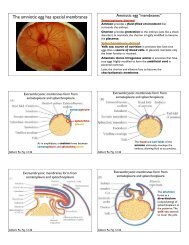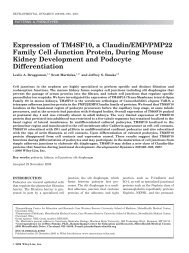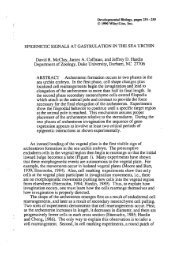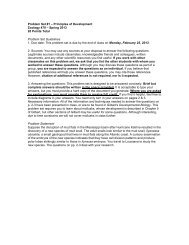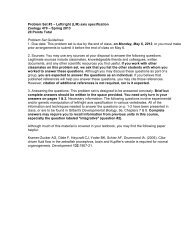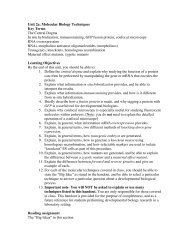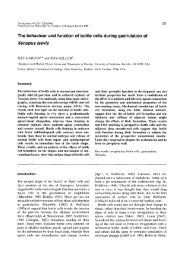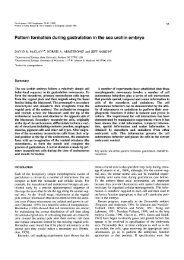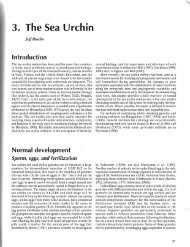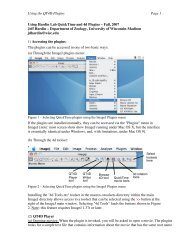WOC 6e Guide to Microscopy
WOC 6e Guide to Microscopy
WOC 6e Guide to Microscopy
You also want an ePaper? Increase the reach of your titles
YUMPU automatically turns print PDFs into web optimized ePapers that Google loves.
on the arm of the micro<strong>to</strong>me, which advances the specimen<br />
by small increments <strong>to</strong>ward a metal or glass blade that slices<br />
the tissue in<strong>to</strong> thin sections. As successive sections are cut,<br />
they usually adhere <strong>to</strong> one another, forming a ribbon of thin<br />
sections. These sections are then mounted on a glass slide<br />
and subjected <strong>to</strong> staining with any of a variety of dyes that<br />
have been adapted for this purpose. Sometimes the tissue is<br />
treated with a single stain, but more often a series of stains is<br />
used, each with an affinity for a different kind of cellular<br />
component. Once stained, the specimen is covered with a<br />
glass coverslip for protection.<br />
A his<strong>to</strong>rically important approach for localizing specific<br />
components within cells is microscopic au<strong>to</strong>radiography, a<br />
technique that uses pho<strong>to</strong>graphic emulsion <strong>to</strong> determine<br />
where a specific radioactive compound is located within a cell<br />
at the time the cell is fixed and sectioned for microscopy. In<br />
this procedure, radioactive compounds are incubated with<br />
tissue sections or administered <strong>to</strong> intact cells or organisms.<br />
After sufficient time has elapsed for the radioactive compound<br />
<strong>to</strong> become incorporated in<strong>to</strong> newly forming intracellular<br />
molecules and structures, the remaining unincorporated<br />
radioactivity is washed away and the specimen is sectioned in<br />
the conventional way and mounted on a microscope slide.<br />
The slide is then covered with a thin layer of pho<strong>to</strong>graphic<br />
emulsion and placed in a sealed box for the desired<br />
length of time, often for several days or even weeks. When the<br />
emulsion is later developed and the specimen is examined<br />
under the microscope, silver grains appear directly above the<br />
specimen wherever radiation had bombarded the emulsion.<br />
The location of these silver grains, which are readily visible<br />
(a)<br />
Figure A-25 A Transmission Electron Microscope. (a) A pho<strong>to</strong>graph<br />
and (b) a schematic diagram of a TEM.<br />
A-18 Appendix Principles and Techniques of <strong>Microscopy</strong><br />
with both the light and electron microscope, can be used <strong>to</strong><br />
pinpoint the region of the cell containing the radioactivity.<br />
The Electron Microscope<br />
The impact of electron microscopy on our understanding of<br />
cells can only be described as revolutionary. Yet, like light<br />
microscopy, electron microscopy has both strengths and<br />
weaknesses. In electron microscopy, resolution is much better,<br />
but specimen preparation and instrument operation are often<br />
more difficult. Electron microscopes are of two basic designs:<br />
the transmission electron microscope and the scanning electron<br />
microscope. Scanning and transmission electron microscopes<br />
are similar in that each employs a beam of electrons <strong>to</strong> produce<br />
an image. However, the instruments use quite different<br />
mechanisms <strong>to</strong> form the final image, as we see next.<br />
TRANSMISSION ELECTRON MICROSCOPY<br />
FORMS AN IMAGE FROM ELECTRONS THAT<br />
PASS THROUGH THE SPECIMEN<br />
The most commonly used type of electron microscope is<br />
called the transmission electron microscope (TEM) because<br />
it forms an image from electrons that are transmitted<br />
through the specimen being examined. As shown in Figure<br />
A-25, most of the parts of the TEM are similar in name and<br />
function <strong>to</strong> their counterparts in the light microscope,<br />
although their physical orientation is reversed. We will look<br />
briefly at each of the major features.<br />
Specimen<br />
Specimen<br />
stage<br />
Detec<strong>to</strong>r<br />
(b)<br />
Cathode (tungsten<br />
filament)<br />
Anode<br />
First<br />
condenser<br />
lens<br />
Second<br />
condenser<br />
lens<br />
Objective lens<br />
Intermediate lens<br />
Projec<strong>to</strong>r lens<br />
Electron gun<br />
(inside cylinder,<br />
not shown)<br />
Condenser<br />
lens system



